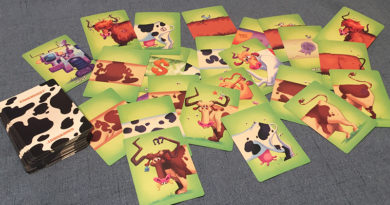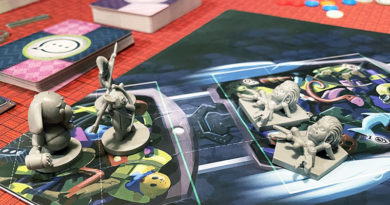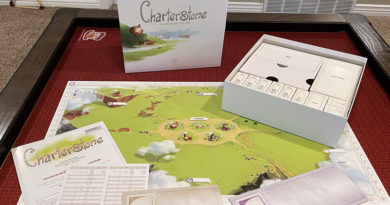Dinner in Paris board game review

Almost 2 years ago (June of 2019), a friend and I traveled to Normandy, France for the 75-year commemoration of the WWII D-Day landings.
It was an amazing experience to visit so many historic sites over the course of our week in France. And we capped the trip off with a final day and a nice dinner in Paris at a cafe near the river Seine.
So when I heard from Funnyfox about their just-released board game, Dinner in Paris, it brought back tons of memories and sparked my interest in playing the game!
Now the big question is…is the game as memorable as my actual last dinner in Paris?
How to play Dinner in Paris
Dinner in Paris is a strategy board game in which players try to become the best restaurant owner on a new plaza. They do so by opening restaurants, building terraces, and winning majorities in various areas.
Set up
After setting out the main board on the correct side depending on the number of players, players shuffle the different sets of cards and place them in their designated spaces on the board. There are Resources, Objectives, Majorities, and Pigeon cards.
Each player takes a player board, 1 translucent yellow cube, as well as 52 “Terrace” tiles and 18 Property tiles in their chosen color. Each player also begins with 4 Resources cards and 2 Objective cards (of which they choose 1 to keep). The discarded Objective cards are then placed face up next to the Objectives draw pile.
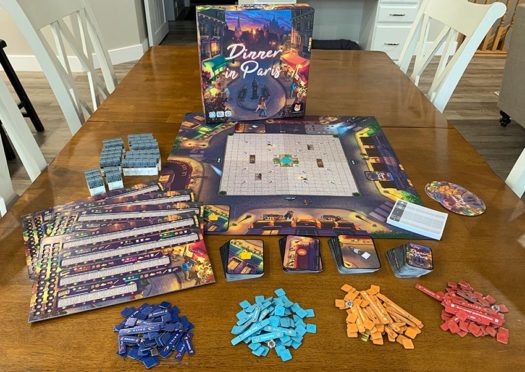
Player turns
A player begins their turn by drawing 1 Resource card. They may choose from one of the 4 face up Resource cards or from the top of the draw pile.
Then they must take 2 actions (they can choose to do the same action twice).
- Draw a Resource Card
- Open a Restaurant
- Build Terraces
- Complete a Personal or Common Objective
Drawing a Resource Card is pretty self-explanatory.
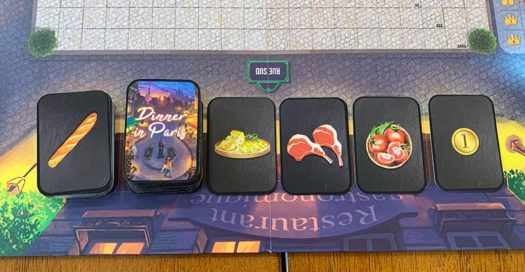
To Open a Restaurant, a player must discard the necessary ingredients as indicated for that restaurant on their player board. For example, to open a Creperie a player must discard 2 Flour and 1 Cheese card.
The player then takes a Restaurant building of that size and places it on the edge of the plaza. To show it’s theirs, they also place one of their corresponding restaurant tiles on the rooftop. The player also advances their income marker based on the amount indicated next to that restaurant on their board.
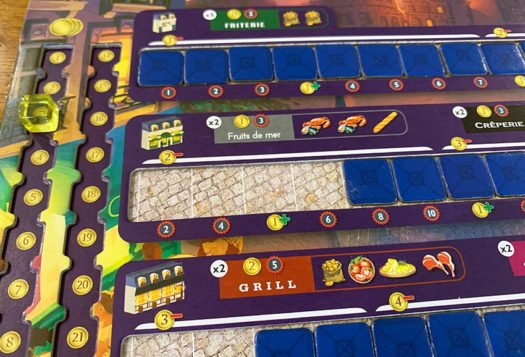
Players can Build Terraces in front of their open restaurants. To do so, they must take them from their player board in the corresponding row. They are removed from left to right and the cost of each Terrace costs is listed in that section of the player board. For example, the first 6 Terraces from the small restaurant row each cost 2.
A player can place as many Terraces as they can afford. The first must be placed in front of the corresponding restaurant and subsequent Terraces must be placed adjacent to an existing one of the same color. The Terraces of two restaurants can never be adjacent (they need their elbow space).
If a Terrace is placed on a space with a Pigeon icon, the player draws a Pigeon card (which grants special actions or resources).
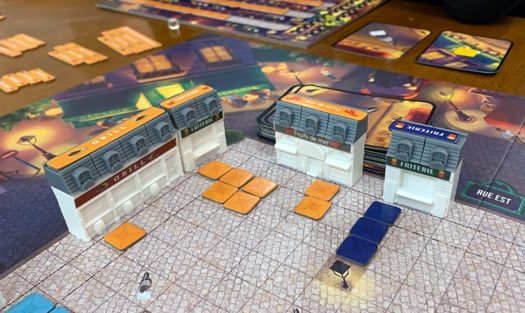
Lastly, a player may also Complete an Objective on their turn. If they have fulfilled the requirement listed on either their personal secret objective or a face up common objective, for an action, they announce completing the objective and place that card face up in front of them. If they completed a personal one, they draw a new objective card. If they think they can complete it by the end of the game, they may keep it as a personal objective. If not, they can place it face up as a common objective.
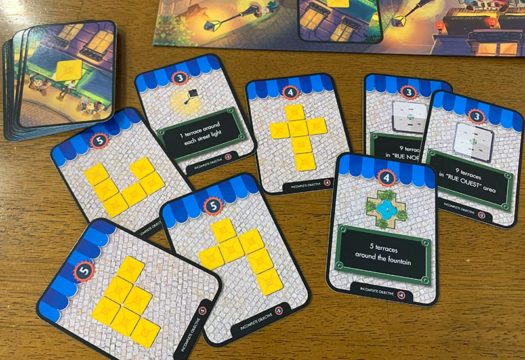
Game end and scoring
Players continue taking turn until one of these 3 conditions is met:
- A certain number of restaurants (based on player count) are opened.
- A player has placed all of their terrace tiles from 2 different restaurant categories.
- It’s not possible to place more restaurants or terraces on the board.
Players then finish the round and tally up their scores.
The included score sheets are helpful to records players’ points in the following categories:
- Victory points from their opened restaurants.
- Victory points from terraces built — the points shown below the last unveiled terrace space on their board.
- Completed objectives — positive points for those completed and negative points for personal objectives not completed.
- Majorities — each of the 3 majorities showing on the Majority card for that game are scored individually. Players score points depending on their ranking position in each of those categories.
The player with the most points wins!
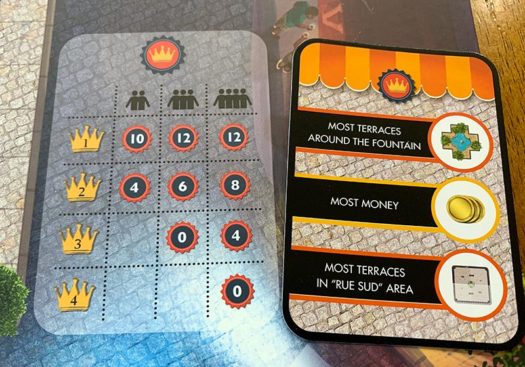
Can the whole family enjoy Dinner in Paris?
While Dinner in Paris falls in the family board game category, there are plenty of things to think about during a game. As such, it’s not going to appeal to everyone in the family.
It’s not that the game is complicated. After all, on a player’s turn, they only need to draw a resource card and then take 2 actions.
But rather, it’s the way those choices work together that add layers of strategy to the game.
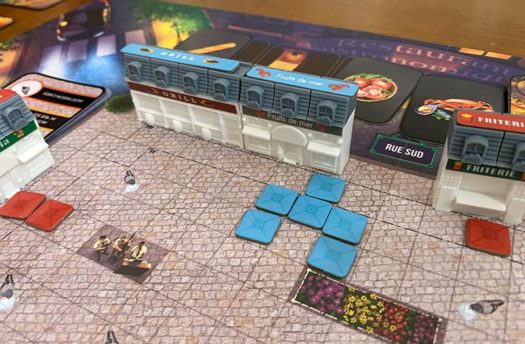
First of all, players must open restaurants to get anywhere in the game. To do that, they need Resource cards. So that’s an obvious choice to get more cards.
But then they must choose where to place that restaurant when they open it. That may seem like a simple option, but there are a number of factors to take into account.
Which restaurants will give them the best income? How close do they want to be to other restaurants? Which street do they want to build on? Where can they build to get Pigeons? Which area will help them score better with the Majorities that are in play this game? and so on.
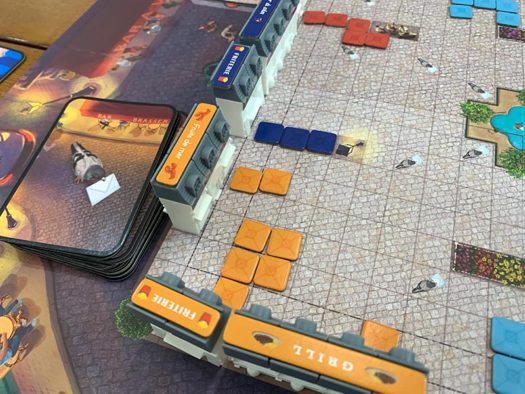
Once players have a restaurant or two in play, they’ll want to get terraces in front of them. And while doing so sounds simple, again players must build in such a way that they can complete objective cards. Because most of those are based on the shapes their combined terraces form. Thus adding a spacial element to the game.
All that being said, we enjoy games that make you think. And Dinner in Paris does just that.
One of the things we really like about the game is the Majorities. There are 8 Majorities cards included in the game. Each card shows 3 different elements players can score majorities for. But only 1 Majorities card is in play for each game!
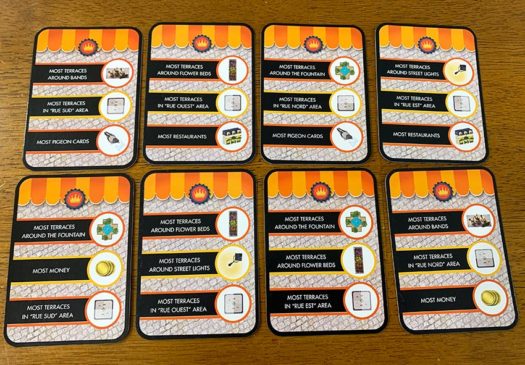
Which means that each game is going to play out differently depending on which ones are the target for that game. It may be the most money, the most pigeon cards, the most terraces closets to bands, the most on a certain street, etc.
It adds a nice element of variety for each game.
We also like that there are a number of ways to score points during the game. And concentrating on just one element may not be the best strategy. You’ll want to make sure you’re covered in each different scoring area along the way (restaurants, terraces, objectives, and majorities) to do well.
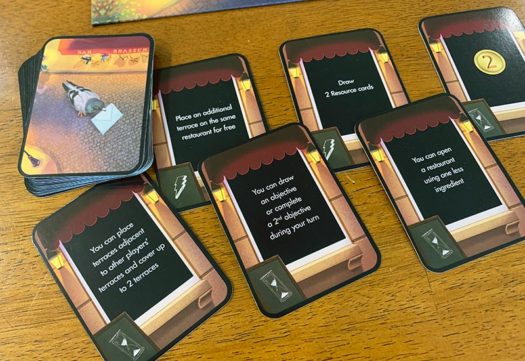
Most of the components are fantastic
I know that may seem like an “attention-getter” headline for this part of the review. But there really is only one component element that we wish were better – the card quality.
We’re not experts in paper, but we can readily tell that the paper quality of the cards isn’t as good as we’ve come to expect from modern board games. That being said though, the card artwork is very easy to read and quickly understand what you’re looking for.
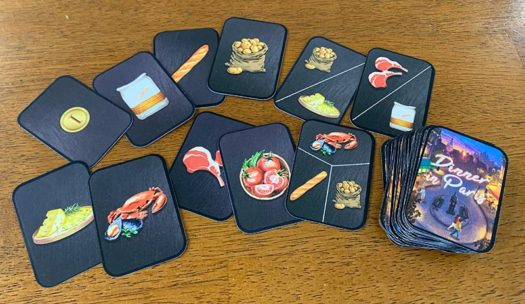
Now on to the good stuff — everything else.
The double-sided game board sets the scene well for a plaza in Paris. And the places for the different types of cards are easy to spot. Everything has its place.
And the restaurants themselves are terrific. It’s fun to see them pop up around the board as players place them on the edges to mark their areas.
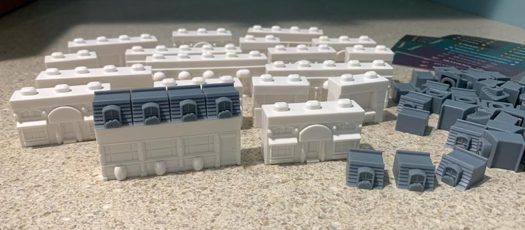
Just take note that before your first game, you’ll need to assemble the restaurant pieces. The bases, the rooftops, and the restaurant names all need to be constructed. The tricky part is placing the stickers on the front and back of each building. But once done, you’re all set.
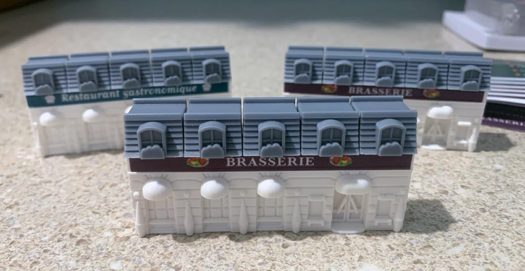
While they’re pretty cool, the component we love the most is the double-thick player boards!
Since these boards keep track of so much, we love the inset spaces for the terrace pieces and income markers. Because they’re inset, you don’t have to worry about a slight bump to your player board messing up your tacking. Everything stays in its place perfectly.
Nicely done Funnyfox!
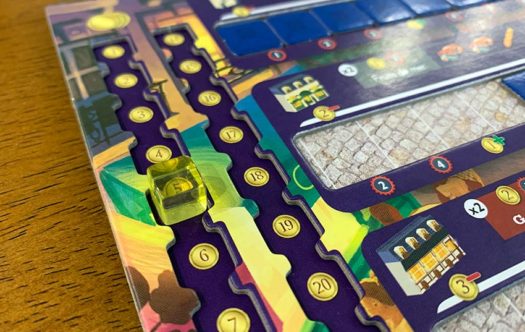
How does Dinner in Paris score on our “Let’s Play Again” game meter?
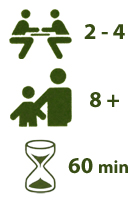 Like the name suggests, Dinner in Paris is a solid meal of a game. It fits squarely between an appetizer and dessert.
Like the name suggests, Dinner in Paris is a solid meal of a game. It fits squarely between an appetizer and dessert.
And as such, like not eating two dinners in a row, we haven’t played any back to back games of Dinner in Paris. Yet it is a game that will hit the table again.
The game may not be as memorable as my last actual dinner in Paris in 2019 (because it will be very hard to top that trip) but it is a visually pleasing and enjoyable game that makes you think.
It’s a recipe for a pleasing evening with the family.
We’d like to thank Funnyfox for a review copy of Dinner in Paris.



